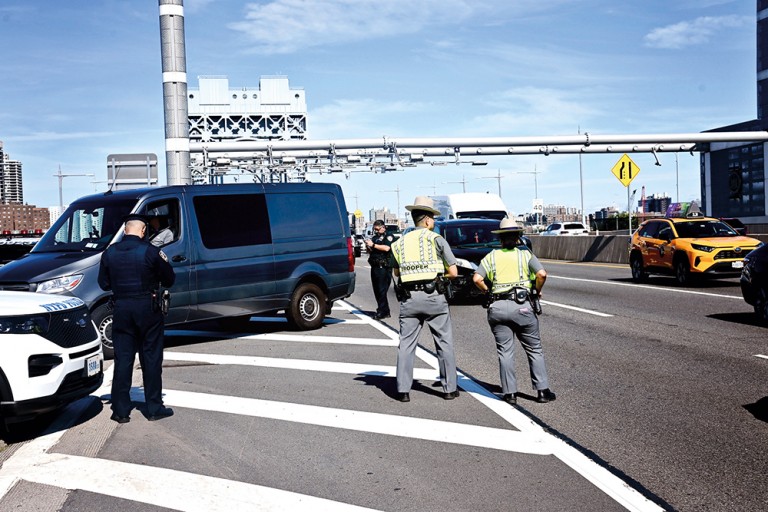By Forum Staff
Metropolitan Transportation Authority Bridges and Tunnels along with regional law enforcement partners on Tuesday highlighted results of 100 operations following the launch of a multi-agency City and State-led task force dedicated to removing “ghost cars”—vehicles that are virtually untraceable by traffic cameras and toll readers because of their forged or altered license plates—from New York roadways.
The 100 joint enforcement operations, which began 15 months ago, have resulted in 5,343 vehicles towed for suspended registrations and fraudulent, obstructed or altered license plates. Additionally, unbillable tolls from ghost plates have dropped 20 percent.
So far in 2025, there have been 38 enforcement operations, which resulted in 1,893 towed vehicles with approximately $11.5 million in unpaid tolls and fees, judgments and debts owed to all task force partners. MTA Police and Bridge and Tunnel officers alone have issued 16,000 summonses year-to-date.
The number of criminal possession of a forged instrument, or ghost plates, confiscated this year is 48 and 126 throughout 100 joint enforcement operations. Since the launch of congestion relief in January 2025, the role of the task force has expanded to include operations targeting vehicles committing violations in and around the Congestion Relief Zone in Manhattan. The 11 CRZ operations have resulted in 97 towed vehicles.
Governor Kathy Hochul secured in the Fiscal Year 2025 final budget agreement an increase in fines and penalties for driving with altered plates, a prohibition of the sale or distribution of covers that obscure license plates and the restriction of DMV registration transactions for vehicles with suspended registrations for failure to pay tolls or failing to remove plate-obscuring materials. MTA Bridges and Tunnels also reduced fees assessed for toll violations on its major bridges and tunnels.
The primary focus of the task force’s work is to remove vehicles with fraudulent or modified license plates—and those with no tags at all—as these vehicles are often unregistered, uninsured, or stolen. While the illegal practice of forging or altering license plates is not new, the crime proliferated during the pandemic, with drivers masking their identities by using counterfeit temporary paper plates to evade detection. Fake temporary tags appeared as though they were issued by out-of-state dealerships, making them difficult to verify. In some cases, vehicle operators used this cloak of anonymity to commit more serious violent crimes, including hit-and-runs, robberies and shootings.
One notable arrest occurred in June at the Whitestone Bridge. MTA cops received an alert for a stolen license plate. Officers tried to conduct a traffic stop but the vehicle fled and ended up crashing into another car. The officers chased the driver on foot and placed him into custody. The vehicle had been stolen, and the driver was in possession of a loaded firearm and large amount of marijuana.
“The use of fraudulent and obstructed or defaced license plates undermines public safety and puts everyone on the roadway at risk,” said State Police Superintendent Steven James. “Enforcements such as this are an integral part of protecting all New Yorkers and for maintaining the welfare of the roads they rely on each day.”

